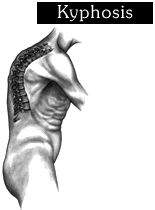- What is Kyphosis (Scheuermann’s disease; Roundback; Hunchback; Postural kyphosis)
- Statistics on Kyphosis (Scheuermann’s disease; Roundback; Hunchback; Postural kyphosis)
- Risk Factors for Kyphosis (Scheuermann’s disease; Roundback; Hunchback; Postural kyphosis)
- Progression of Kyphosis (Scheuermann’s disease; Roundback; Hunchback; Postural kyphosis)
- Symptoms of Kyphosis (Scheuermann’s disease; Roundback; Hunchback; Postural kyphosis)
- Clinical Examination of Kyphosis (Scheuermann’s disease; Roundback; Hunchback; Postural kyphosis)
- How is Kyphosis (Scheuermann’s disease; Roundback; Hunchback; Postural kyphosis) Diagnosed?
- Prognosis of Kyphosis (Scheuermann’s disease; Roundback; Hunchback; Postural kyphosis)
- How is Kyphosis (Scheuermann’s disease; Roundback; Hunchback; Postural kyphosis) Treated?
- Kyphosis (Scheuermann’s disease; Roundback; Hunchback; Postural kyphosis) References
What is Kyphosis (Scheuermann’s disease; Roundback; Hunchback; Postural kyphosis)

Statistics on Kyphosis (Scheuermann’s disease; Roundback; Hunchback; Postural kyphosis)
The prevalence of Kyphosis is estimated to affect 4-8% of the general population. While the prevalence of Kyphosis is generally accepted to be essentially equal in males and females, this finding is debated in literature.
Risk Factors for Kyphosis (Scheuermann’s disease; Roundback; Hunchback; Postural kyphosis)
In adults, kyphosis can be a result of osteoporotic compression fractures (fractures caused by osteoporosis), degenerative disease (such as arthritis), or spondylolisthesis (slipping of one vertebra forward on another). Other causes of kyphosis include the following:
- Infection (such as tuberculosis)
- Neurofibromatosis
- Connective tissue disorders
- Muscular dystrophy
- Spina bifida (a birth defect involving incomplete formation of part of the spine)
- Disk degeneration
- Certain endocrine diseases
- Paget’s disease
- Polio
- Tumors Kyphosis can also be seen in association with scoliosis (an abnormal sideways curvature of the spine seen in children and adolescents). Risk factors are related to the cause of the Kyphosis.
How is Kyphosis (Scheuermann’s disease; Roundback; Hunchback; Postural kyphosis) Diagnosed?
A spine x-ray will be done to document the severity of the curve and allow serial measurements to be performed. Occasionally, pulmonary function tests may be used to assess whether the kyphosis is affecting breathing.
Prognosis of Kyphosis (Scheuermann’s disease; Roundback; Hunchback; Postural kyphosis)
Adolescents with Kyphosis tend do well even if they need surgery, and the disease stops once they stop growing. If the kyphosis is due to degenerative joint disease or multiple compression fractures, correction of the defect is not possible without surgery, and improvement of pain is less reliable.
How is Kyphosis (Scheuermann’s disease; Roundback; Hunchback; Postural kyphosis) Treated?
Treatment depends on the cause of the disorder:
- Congenital kyphosis requires corrective surgery at an early age.
- Scheuermann’s disease is initially treated with a brace and physical therapy.
- Occasionally surgery is needed for large (greater than 60 degrees), painful curves.
- Multiple compression fractures from osteoporosis can be left alone if there is no neurologic problems or pain, but the osteoporosis needs to be treated to help prevent future fractures. For debilitating deformity or pain, surgery is an option.
- Kyphosis secondary to infection or tumor needs to be treated more aggressively, often with surgery and medications. Treatment for other types of kyphosis depends on the cause. Surgery may be necessary if neurological symptoms develop.
Kyphosis (Scheuermann’s disease; Roundback; Hunchback; Postural kyphosis) References
- eMEDICINE
- Kumar and Clark: Clinical Medicine 4th Edition (1998) pg 522
- MEDLINE Plus
All content and media on the HealthEngine Blog is created and published online for informational purposes only. It is not intended to be a substitute for professional medical advice and should not be relied on as health or personal advice. Always seek the guidance of your doctor or other qualified health professional with any questions you may have regarding your health or a medical condition. Never disregard the advice of a medical professional, or delay in seeking it because of something you have read on this Website. If you think you may have a medical emergency, call your doctor, go to the nearest hospital emergency department, or call the emergency services immediately.







